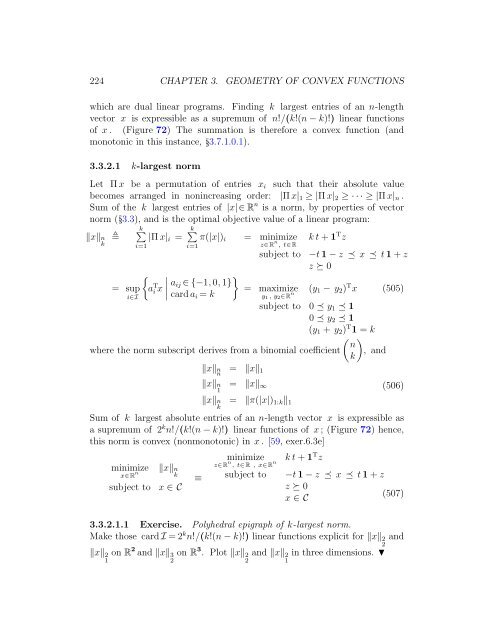Chapter 3 Geometry of convex functions - Meboo Publishing ...
Chapter 3 Geometry of convex functions - Meboo Publishing ...
Chapter 3 Geometry of convex functions - Meboo Publishing ...
You also want an ePaper? Increase the reach of your titles
YUMPU automatically turns print PDFs into web optimized ePapers that Google loves.
224 CHAPTER 3. GEOMETRY OF CONVEX FUNCTIONS<br />
which are dual linear programs. Finding k largest entries <strong>of</strong> an n-length<br />
vector x is expressible as a supremum <strong>of</strong> n!/(k!(n − k)!) linear <strong>functions</strong><br />
<strong>of</strong> x . (Figure 72) The summation is therefore a <strong>convex</strong> function (and<br />
monotonic in this instance,3.7.1.0.1).<br />
3.3.2.1 k-largest norm<br />
Let Πx be a permutation <strong>of</strong> entries x i such that their absolute value<br />
becomes arranged in nonincreasing order: |Πx| 1 ≥ |Πx| 2 ≥ · · · ≥ |Πx| n .<br />
Sum <strong>of</strong> the k largest entries <strong>of</strong> |x|∈ R n is a norm, by properties <strong>of</strong> vector<br />
norm (3.3), and is the optimal objective value <strong>of</strong> a linear program:<br />
k∑ ∑<br />
‖x‖n |Πx| i = k π(|x|) i = minimize k t + 1 T z<br />
k i=1 i=1<br />
z∈R n , t∈R<br />
subject to −t1 − z ≼ x ≼ t1 + z<br />
z ≽ 0<br />
{<br />
= sup a T i x<br />
i∈I<br />
∣ a }<br />
ij ∈ {−1, 0, 1}<br />
carda i = k<br />
= maximize (y 1 − y 2 ) T x<br />
y 1 , y 2 ∈R n<br />
subject to 0 ≼ y 1 ≼ 1<br />
0 ≼ y 2 ≼ 1<br />
where the norm subscript derives from a binomial coefficient<br />
‖x‖n n<br />
= ‖x‖ 1<br />
(y 1 + y 2 ) T 1 = k<br />
( n<br />
k)<br />
, and<br />
(505)<br />
‖x‖n<br />
1<br />
= ‖x‖ ∞<br />
(506)<br />
‖x‖n<br />
k<br />
= ‖π(|x|) 1:k ‖ 1<br />
Sum <strong>of</strong> k largest absolute entries <strong>of</strong> an n-length vector x is expressible as<br />
a supremum <strong>of</strong> 2 k n!/(k!(n − k)!) linear <strong>functions</strong> <strong>of</strong> x ; (Figure 72) hence,<br />
this norm is <strong>convex</strong> (nonmonotonic) in x . [59, exer.6.3e]<br />
minimize ‖x‖n<br />
x∈R n k<br />
subject to x ∈ C<br />
≡<br />
minimize<br />
z∈R n , t∈R , x∈R n<br />
subject to<br />
k t + 1 T z<br />
−t1 − z ≼ x ≼ t1 + z<br />
z ≽ 0<br />
x ∈ C<br />
(507)<br />
3.3.2.1.1 Exercise. Polyhedral epigraph <strong>of</strong> k-largest norm.<br />
Make those card I = 2 k n!/(k!(n − k)!) linear <strong>functions</strong> explicit for ‖x‖ 22 and<br />
‖x‖ 21 on R 2 and ‖x‖ 32 on R 3 . Plot ‖x‖ 22 and ‖x‖ 21 in three dimensions.
















